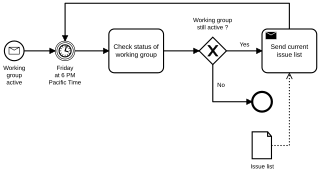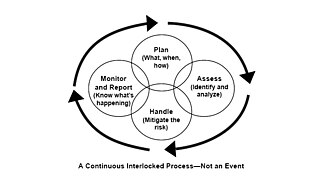Project management is the process of supervising the work of a team to achieve all project goals within the given constraints. This information is usually described in project documentation, created at the beginning of the development process. The primary constraints are scope, time and budget. The secondary challenge is to optimize the allocation of necessary inputs and apply them to meet pre-defined objectives.

Risk management is the identification, evaluation, and prioritization of risks, followed by the minimization, monitoring, and control of the impact or probability of those risks occurring.
The ISO 9000 family is a set of five quality management systems (QMS) standards by the International Organization for Standardization (ISO) which help organizations ensure that they meet customer and other stakeholder needs within the statutory and regulatory requirements related to a product or service. The ISO refers to the set of standards as a "family", bringing together the standard for quality management systems and a set of "supporting standards", and their presentation as a family facilitates their integrated application within an organisation. ISO 9000 deals with the fundamentals and vocabulary of QMS, including the seven quality management principles that underlie the family of standards. ISO 9001 deals with the requirements that organizations wishing to meet the standard must fulfill. A companion document, ISO/TS 9002, provides guidelines for the application of ISO 9001. ISO 9004 gives guidance on achieving sustained organizational success.
The ISO 14000 family of standards by the International Organization for Standardization (ISO) relate to environmental management that exists to help organizations (a) minimize how their operations negatively affect the environment ; (b) comply with applicable laws, regulations, and other environmentally oriented requirements; and (c) continually improve in the above.
Information technology (IT)governance is a subset discipline of corporate governance, focused on information technology (IT) and its performance and risk management. The interest in IT governance is due to the ongoing need within organizations to focus value creation efforts on an organization's strategic objectives and to better manage the performance of those responsible for creating this value in the best interest of all stakeholders. It has evolved from The Principles of Scientific Management, Total Quality Management and ISO 9001 Quality Management System.

Business process modeling (BPM) is the action of capturing and representing processes of an enterprise, so that the current business processes may be analyzed, applied securely and consistently, improved, and automated.
Quality management ensures that an organization, product or service consistently functions well. It has four main components: quality planning, quality assurance, quality control, and quality improvement. Quality management is focused both on product and service quality and the means to achieve it. Quality management, therefore, uses quality assurance and control of processes as well as products to achieve more consistent quality. Quality control is also part of quality management. What a customer wants and is willing to pay for it, determines quality. It is a written or unwritten commitment to a known or unknown consumer in the market. Quality can be defined as how well the product performs its intended function.
Enterprise risk management (ERM) in business includes the methods and processes used by organizations to manage risks and seize opportunities related to the achievement of their objectives. ERM provides a framework for risk management, which typically involves identifying particular events or circumstances relevant to the organization's objectives, assessing them in terms of likelihood and magnitude of impact, determining a response strategy, and monitoring process. By identifying and proactively addressing risks and opportunities, business enterprises protect and create value for their stakeholders, including owners, employees, customers, regulators, and society overall.
An environmental management system (EMS) is "a system which integrates policy, procedures and processes for training of personnel, monitoring, summarizing, and reporting of specialized environmental performance information to internal and external stakeholders of a firm".
Internal auditing is an independent, objective assurance and consulting activity designed to add value and improve an organization's operations. It helps an organization accomplish its objectives by bringing a systematic, disciplined approach to evaluate and improve the effectiveness of risk management, control and governance processes. Internal auditing might achieve this goal by providing insight and recommendations based on analyses and assessments of data and business processes. With commitment to integrity and accountability, internal auditing provides value to governing bodies and senior management as an objective source of independent advice. Professionals called internal auditors are employed by organizations to perform the internal auditing activity.

ISO 22000 is a food safety management system by the International Organization for Standardization (ISO) which is outcome focused, providing requirements for any organization in the food industry with objective to help to improve overall performance in food safety. These standards are intended to ensure safety in the global food supply chain. The standards involve the overall guidelines for food safety management and also focuses on traceability in the feed and food chain.
Governance, risk management and compliance (GRC) is the term covering an organization's approach across these three practices: governance, risk management, and compliance.
ISO/IEC 27005 "Information technology — Security techniques — Information security risk management" is an international standard published by the International Organization for Standardization (ISO) and the International Electrotechnical Commission (IEC) providing good practice guidance on managing risks to information. It is a core part of the ISO/IEC 27000-series of standards, commonly known as ISO27k.
A safety management system (SMS) is a management system designed to manage occupational safety and health risks in the workplace. If the system contains elements of management of longer-term health impacts and occupational disease, it may be referred to as a safety and health management system (SHMS) or health and safety management system.
ISO 28000:2022, Security and resilience – Security management systems – Requirements, is a management system standard published by International Organization for Standardization (ISO) that specifies requirements for a security management system including aspects relevant to the supply chain.

IT risk management is the application of risk management methods to information technology in order to manage IT risk. Various methodologies exist to manage IT risks, each involving specific processes and steps.
Within project management, risk management refers to activities for minimizing project risks, and thereby ensuring that a project is completed within time and budget, as well as fulfilling its goals.
ISO 50001Energy management systems - Requirements with guidance for use, is an international standard created by the International Organization for Standardization (ISO). It supports organizations in all sectors to use energy more efficiently through the development of an energy Management System. The standard specifies the requirements for establishing, implementing, maintaining, and improving an energy management system, whose purpose is to enable an organization to follow a systematic approach in achieving continual improvement of energy performance, including energy efficiency, energy security, energy use, and consumption.
ISO 19600, Compliance management systems - Guidelines, is a compliance standard introduced by the International Organization for Standardization (ISO) in April 2014. As its title suggests, it operates as an advisory standard and is not used for accreditation or certification.
The NIST Cybersecurity Framework (CSF) is a set of voluntary guidelines designed to help organizations assess and improve their ability to prevent, detect, and respond to cybersecurity risks. Developed by the U.S. National Institute of Standards and Technology (NIST), the framework was initially published in 2014 for critical infrastructure sectors but has since been widely adopted across various industries, including government and private enterprises globally. The framework integrates existing standards, guidelines, and best practices to provide a structured approach to cybersecurity risk management.



